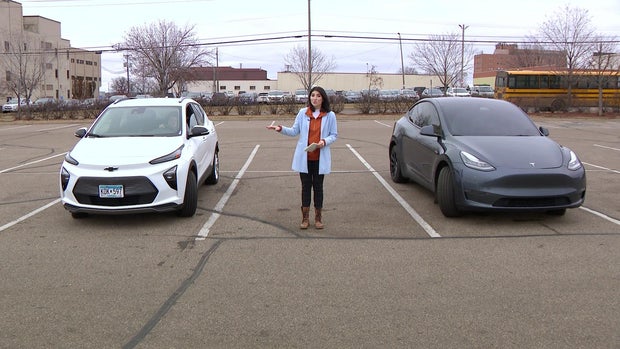TWO HARBORS, Minn. — Scientists agree that burning oil, coal and gas is overheating the planet — but we have the technology to tackle that problem.
One solution: Making the switch to electric vehicles. Home charging options might make them convenient in cities, but what if you want to drive your EV further?
WCCO's Erin Hassanzadeh and producer Joan Gilbertson took a 191-mile trip from St. Paul to Two Harbors in electric vehicles and discovered a few bumps in the road.
Erin drove a Tesla Model Y, which is the most popular EV on Minnesota roads. Joan drove a Chevy Bolt, which is rated as the third most popular EV on Minnesota roads after a couple of Tesla models.
RELATED: Minnesota is now offering rebates for electric vehicle purchases. Here's what you need to know.
With a full, charge Erin had 303 miles of range in the Tesla and Joan had 209 in the Bolt.
EV consultant Jukka Kukkonen says the EVs will automatically heat up that battery and that will make it charge faster.
PlugShare, a popular app for EV drivers to find charging stations, showed the Moose Lake charger for Joan's Bolt as offline.
About an hour into the road trip, in 37-degree weather, the Tesla's range was down to 69% or 211 miles. The Bolt's range was under 120 miles.
Due to the Moose Lake charger being offline, a change of plans led Erin and Joan to an abandoned parking lot near a Walmart and gas station.
After 50 minutes of charging, they felt confident the Bolt could make it another 125 miles to the lodge. They made a lunch stop in Hinckley to supercharge the Tesla.
While enjoying some road trip staples, they set a timer for 45 minutes and fully charged the Tesla.
Farther down the road in Duluth, they found more chargers that were down. That's not the only challenge either, just ask Jon Sullivan with Minnesota Power, a North Shore utility company.
"The number one question I always have is about range and how that's impacted during the wintertime," Sullivan said.
RELATED: Drivers say electric vehicle batteries perform worse amid cold weather
The ideal outdoor temperature for an EV battery is 70-80 degrees. They can lose up to 40% of their range just from the cold.
While it was above freezing during the trip, neither car was living up to its expected range. Driving slower and turning down cab comforts like heat would help. So would more charging stations, like those planned for interstates 94 and 35.
Sullivan assured WCCO there are plans to fill in the other gaps too.
"We received approval to install 16 fast chargers throughout our territory — two in Duluth and a lot in rural areas."
Troy Melichar manages Larsmont Cottage in Two Harbors, where they've had chargers for guests for nearly 10 years.
"We get inquiries not daily but weekly about our charging," Melichar said. "Doubling that capacity would probably be the next step."
In the end, both cars used more battery range than expected for the drive. Both cars stopped for 45-50 minutes to charge, which cost around $10 each for the trip. On the other hand, photojournalist Mike Durenberger spent $20 on gas.
"electric" - Google News
February 20, 2024 at 11:19AM
https://ift.tt/In6E0c8
WCCO tests the long-distance capabilities of electric vehicles - CBS Minnesota
"electric" - Google News
https://ift.tt/QxkwRWT
https://ift.tt/fevsBLV


No comments:
Post a Comment